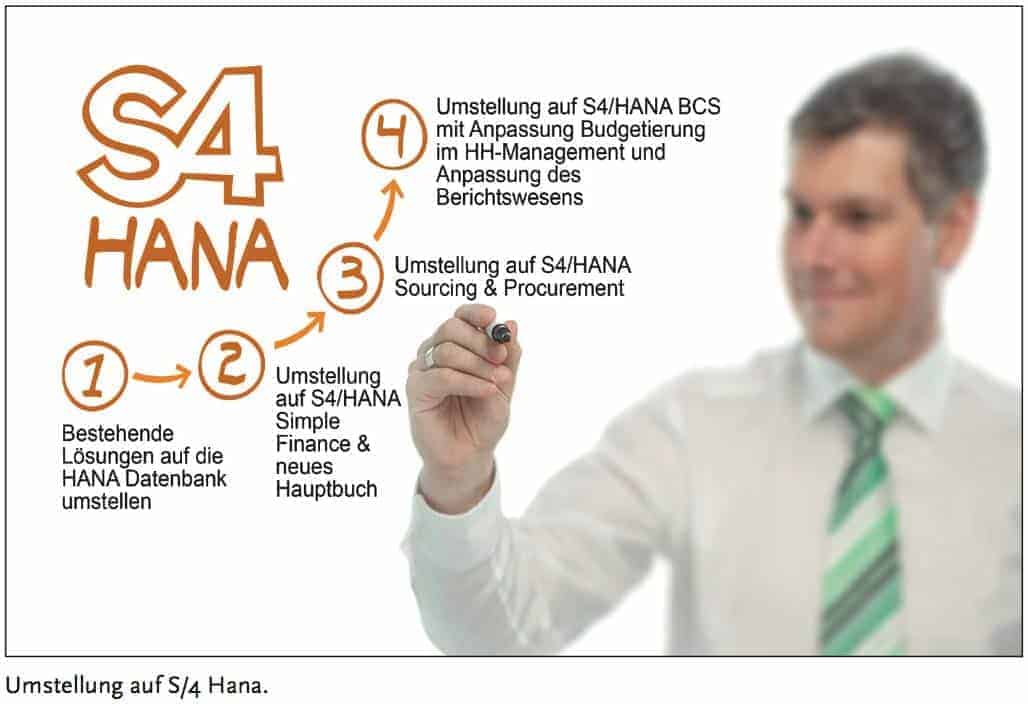City/4 Hana
![[shutterstock.com:539761528, BrainBistro]](https://e3mag.com/wp-content/uploads/2016/09/shutterstock_539761528.jpg)

Hana and S/4 Hana are conquering companies. According to a survey by Techconsult entitled "Business processes in the fast lane in the future", 60 percent of companies are seriously planning to introduce the new in-memory technology.
Public-sector companies are still holding back, but examples such as the Zweckverband Kommunale Datenverarbeitung Oldenburg (KDO) show: Here, too, the new technology from Walldorf has arrived.
No wonder, after all, it promises a whole range of benefits, such as easier and faster provision of reports, more user-friendly interfaces with Fiori, and reduced operating costs due to lower storage requirements as a result of data compression.
Against this background, KDO has promised its customers that it will migrate its doppik&more solution to S/4 Hana by 2018.
 Skepticism remains predominant
Skepticism remains predominant
However, many users in the public sector remain skeptical. For now, they are happy about SAP's guarantee to continue maintaining the current ERP version until 2025.
Probably also because they know: Greater efficiency in processes through innovation is not just a question of technology, but above all of organization and culture.
Many German cities and municipalities have been experiencing this for years with the introduction of municipal double-entry bookkeeping. To this day, the principles of commercial accounting have by no means really arrived in all authorities and municipal companies.
Nevertheless, or precisely because of these experiences, dealing with S/4 Hana is not something that should be put on the back burner in the municipalities. Because especially where the status quo is experienced as unsatisfactory, for example due to user interfaces that users cannot cope with, S/4 Hana offers considerable potential for optimization.
With Fiori, for example, the user interface of applications can be easily and quickly adapted to the respective role of the user and to the display on different end devices. But the real qualities of Hana technology lie deeper.
Hana is a technology optimized for processing large volumes of data. It thus offers municipalities the opportunity not only to manage their ever-growing mountains of data more efficiently, but also to use it more effectively.
Reporting on operational data
This is made possible by SAP Hana's in-memory technology, which eliminates the separation between operational and reporting data.
Until now, users have had to transfer the data for certain evaluations from Financial Accounting, Asset Accounting, Materials Management and Human Resources to a special system such as SAP Business Warehouse (BW). Here, if necessary, they are enriched with information from other specialist applications - including those outside the SAP world.
This could be data from the residents' registration office, for example, when it comes to transmitting administrative costs per inhabitant, per district or for a specific age group.
Although this procedure does provide the municipality with valuable insights, it has several disadvantages: For one thing, it requires considerable manual effort. And since personnel resources in municipal IT are notoriously scarce, most municipalities are sitting on mountains of data that they cannot use or can only use inadequately.
Then there are the administrative costs of running two different systems.
Evaluations in the working memory
Here, in-memory technology provides a paradigm shift: Since the evaluations are executed in the working memory on the operational data, they not only run on the most current data stock, but also considerably faster.
Municipalities can benefit from this, for example, with the annual assessment, when the levy notices are issued for all citizens, companies and properties. In this process, several types of revenue such as property tax, street cleaning, and garbage fees must be combined, usually with four due dates per year.
In a municipality with 300,000 inhabitants, this could easily take a whole day. A process optimized with SAP Hana, on the other hand, could be completed within a few hours.
Proprietary developments and high effort
In addition, S/4 Hana delivers a new form of integration of data and applications, where there is no longer a distinction between asset accounting, general ledger, accounts payable, accounts receivable, materials management, etc. However, this also requires the adaptation of all SAP-based specialist applications. The amount of effort required by the individual municipality essentially depends on the way in which it has used its SAP software to date.
Many have developed and operated individual solutions based on the SAP ERP standard plus Public Sector Management themselves or in collaboration with a consulting firm. In the process, tens, sometimes even hundreds of specialized procedures were connected to SAP via the interface.
In order to place such a largely individual application infrastructure on the basis of Hana, a complete redesign is usually required. Keeping costs under control in the process requires a very thorough analysis of the effort required for the many small details of the conversion.
Municipalities that receive their SAP solution from a service provider such as Datenzentrale Baden-Württemberg or KDO have an easier time of it here, because they only have to roll out what is provided by their respective partner. In general, a step-by-step approach is recommended for the changeover.
Step one: Introduce Hana database
The first step is usually the introduction of a Hana database. This step alone can bring considerable benefits. However, many details are important here, such as the connection and the volume of data to be processed.
For example, in a police application, the runtime of certain queries was reduced from days to minutes by switching from a traditional relational database to SAP Hana.
Another advantage of switching to the Hana database comes from its data storage structure, which is optimized for large data volumes. As a result, Hana has lower storage requirements.
Experts speak of a ratio of up to 1:10 compared to a conventional relational database. And even though physical data storage is becoming increasingly inexpensive, if you factor in the costs of data management and backup, there are definitely significant savings opportunities.
In addition, Hana technology not only lays the foundation for S/4 Hana applications, but also for the development and integration of other, SAP-independent specialist applications.
Step two: Switch to S/4 Hana
The new generation of SAP software not only works with a completely new technology, it is also structured completely differently. Among other things, this means that certain application areas in S/4 Hana can no longer be mapped with the previous functionalities (transactions, etc.). Therefore, the following sequence is recommended for the implementation of S/4 Hana:
- Conversion of the FI and CO modules to S/4 Hana Finance ("Simple Finance") including the technical changeover to the new general ledger ("Universal Journal").
- Conversion from SD/MM to S/4 Hana Sourcing & Procurement.
These two substeps are strongly technically oriented. Neither input nor output structures change. Previous processes and evaluations continue unchanged or with minor changes. - Conversion of budgeting in Funds Management to Business Consolidation (BCS) and the associated adjustments to reporting.
This final sub-step will have varying degrees of impact on processes, evaluations, and input and output structures. This provides the opportunity to test and, if necessary, implement new functionalities.
In general, the following applies in this context: In order to exploit the new possibilities and advantages of S/4 Hana, it is advisable to adapt the content of SAP-based municipal applications to S/4 Hana.
This includes, for example, the conversion of budgeting from SAP CO to the new SAP PSM (Public Sector Management). This results in concrete benefits and simplifications for the municipalities.
However, the most important prerequisite for municipalities on the road to S/4 Hana is the willingness to put all additional developments in SAP to the test without reservation.





